Uechi Kanbun, an icon in Okinawan karate history, introduced Uechi-ryu karate to Okinawa. The Okinawan Prefectural Government recognizes Uechi-ryu as one of the three major roots of all Okinawan karate along with Shuri-te and Naha-te. Uechi Kanbun spent thirteen years in China mastering a quanfa style called Pangainoon (half-hard, half-soft). He taught the style, later called Uechi-ryu, in China, Japan, and Okinawa. Some believe Chinese health exercises and fighting forms were developed by observing animals. At that time, the general health of the Chinese people was poor. Scholars believed diseases were caused by inactivity. They observed that animals were very fit and began watching their living habits.
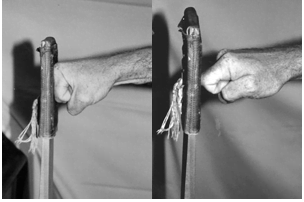
The word ken means knuckle. Ken has been expanded in the martial arts to mean fist and encompasses many fist or hand strikes. Seiken (left), a fundamental two-knuckle fist, is the most popular hand weapon in karate. It is the least difficult fist to for m and the safest to use, therefore, it is good for beginners. The shoken (right), one-knuckle fist, is more difficult to form and condition, therefore, it is a more advanced technique.
The next step in this comparative development was to determine how animals fought one another and who most often survived. Fighting moves emulating animals, such as the tiger, snake, monkey, dragon, and birds native to China, is one source of origin attributed to their fighting systems. Uechi Kanbun favored the more difficult and effective of these striking techniques: shoken (one knuckle punch), sokusen (big toe kick), and nukite (finger-tip strike). These strikes are symbolically referred to as the tiger’s teeth and the crane’s beak. Closed hand techniques predominate in many martial arts styles and are called heishu. There are three types of closed hand strikes in Uechi-ryu karate. They are tsuki, uchi, and ate. Tsuki means thrust and applies to all forward thrusting actions, such as a straight punch. The Romaji spelling of tsuki changes to zuki when used with another word, as in seiken zuki (two-knuckle strike). Uchi strikes are roundhouse or swinging strikes. Ate (pronounced autay) is used to describe strikes with larger surface weapons like the knee and elbow. Open hand strikes, used extensively by Chinese and Okinawan styles, are called kaishu. There are three types of open-hand strikes used in Uechi-ryu karate: nuki, uchi, and tsuki. Nuki means attacking with a smaller weapon in a poking motion. Uchi (circular) and tsuki (straight) striking methods are the same as with closed-hand techniques, however, many parts of the hand can be used.
PUNCHNG TECHINQUES
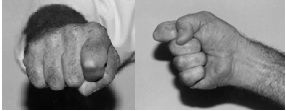
Uechi-ryu’s shoken fist symbolizes a tiger’s teeth. Notice how the thumb overlaps or wraps around the index finger to give it maximum support.
There are no seiken punches in Sanchin, Seisan, or Sanseryu, the original three kata of Uechi-ryu karate. The Chinese origins of this system emphasized many other striking techniques delivered to precise targets or pressure points (kyusho). Kanshiwa kata, created by Uechi Kanei, is the only Uechi-ryu kata that contains seiken punches. The literal translation of shoken is “small knuckle.” This refers to the second knuckle of the index finger, the proximal joint. A shoken fist is made very similar to a seiken fist except that the forefinger is brought forward and locked against the thumb. It is chambered and delivered in the same manner as seiken zuki. Shoken is a dominate weapon of the Uechi-ryu system and is found in supplementary exercises (hojo undo) and all katas except Sanchin. Shoken is used only to attack soft spots and pressure points, such as the throat, neck, solar plexus, armpit, ribcage, arms, and legs. Shoken is called the tiger’s tooth. This punch is compared to being bitten by a tiger. The tissue damage caused by a shoken punch is more intense than the blunt result of a seiken punch. It delivers more destructive power than any other hand strike because the force of the punch is focused into a very small area. The impact penetrates deep into the body.
KICKING TECHINQUES
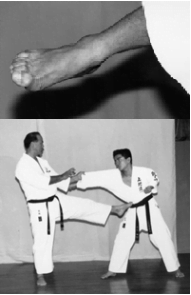
The big toe kick (sokusen) of Uechi-ryu karate emulates the tiger’s bite. Sensei Shinjo Kiyohide demonstrates the penetrating effects of this effective technique on his son Shuichi, of Kadena, Okinawa.
Kicking in Uechi-ryu karate differs from many other styles. The front-leg snap kick is the only kick used in the katas brought from China. It is found in every kata of Uechi-ryu except Sanchin, which contains no kicks. The front-leg kick, like the lead hand punch, is the first line of defense, as it is the closest technique to the opponent. It can be executed quickly against an incoming attacker. This approach exemplifies the “defense only” philosophy of Uechi-ryu karate. The snapping of the kick is an important source of power since the hips cannot be used in the front-leg kick as effectively as with a rear-leg kick. Front kicks in traditional Okinawan kata are aimed at the middle (chudan) or lower (gedan) areas of the body. Kicks that are normally performed by most systems with the ball of the foot, sokutei, are executed in Uechi-ryu karate with the tip= of the big toe (sokusen). Kicks with the ball of the foot do not exist in this system. Sokusen geri is the only kick in the original three katas brought from China. Like the shoken fist, sokusen kicks emulate the destructive effect of a tiger’s teeth. These techniques deliver an enormous amount of power to a small area. Deeper body penetration and more damage to the area attacked are the results. Any part of the body is a potential target for sokusen. Newer students should practice kicking with the ball of the foot for their own safety. Preparing the toes for kicking is an arduous process. First the mus
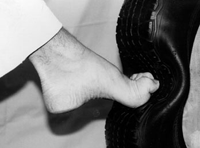
Developing the toes for kicking is an arduous, painstaking task requiring years of dedication. An old tire makes an ideal target.
cles in the toes must be developed so they can be flexed into the proper position. This can take several months. Second, the tip of the toe must be conditioned to take hard contact. This takes several years. To form sokusen, pull your toes back toward your foot, tightening all toes together. Here are six methods for strengthening sokusen technique:
- Make a tight sokusen foot and walk on the tips of the toes.
- Jump up and down on sokusen toes.
- Kick in the air with a tight sokusen foot.
- Kick the makiwara, tire, and sandbag with sokusen.
- Keep a tight sokusen foot when you do Sanchin kata.
- Use sokusen when practicing all kicks.
OPEN HAND TECHNIQUES
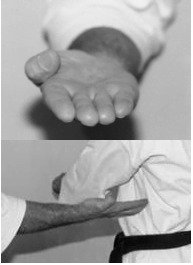
To execute a nukite strike, tighten all four fingers together and place the thumb firmly against the ridge of the hand. Legend contends that ancient Okinawan karate masters could penetrate the rib cage like a spear using a nukite strike.
Nukite is an advanced technique that is very prevalent in the Uechi-ryu system. It is found in all eight katas. Like a shoken punch and sokusen kick, it delivers the primary point of impact to a very small area. Attacking pressure points and soft body parts with this specific strike allows you to inflict maximum damage using little movement. Therefore, body size and strength are not a major factor for effectiveness. When you form your hand for a nukite strike, tighten all four fingers together and place the thumb firmly against the ridge of the hand. When you tighten your fingers, they will naturally curve in slightly. It is important not to let the fingers bend backward on impact. The name of the striking weapon changes as the hand is bent to apply fingertip strikes from different angles, such as kakushiken and koken. To form kakushiken, bend all four fingers where they join the hand and support them by placing the thumb at the base of the forefinger. Kakushiken is executed with the fingertips, in a forceful downward strike, like the beak of a desperate bird defending its life. Snapping the elbow and wrist increase the power. The targets of the crane’s beak are the neck, throat, and soft area behind the collar bone. Kakushiken, an advanced and deadly technique, is found only in Sanseryu kata.
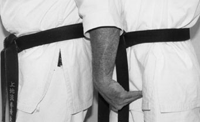
Kakushiken (left) simulates the damage of a downward thrust of a crane’ beak. Targets of the koken strike (right) are the groin and the nerves in the pelvic area.
Koken is formed the same as the kakushiken strike but is applied differently. A large swinging motion is used to deliver this downward strike. To increase power in this technique, a scooping action is added at the point of contact. The targets of this strike are the groin and nerves in the pelvic area. This technique is effective against a grab from behind. Uechi Kanbun told a story to Shinjo Seiyu about a Chinese martial artist who visited him and discussed an interesting conditioning exercise emulating a crane. The man dumped a small bag of rice on the dojo floor. He picked the rice up, one grain at a time, with the fingertips, much in the way a bird would pick them up with its beak. As the grains of rice disappeared, the strength of the man’s developed fingertips became apparent. The visitor explained that in a fight he could apply his pecking and pinching techniques to the veins in the arms of his opponent, causing deadly internal bleeding.
Uechi became intrigued with this idea and stood up, directing the man to demonstrate the technique on him. Several attempts were made but none were successful because of the extreme development of Uechi’s arms. Arm conditioning (kote kitae) had rendered the crane technique ineffective. The degree of conditioning necessary to develop these advanced striking techniques are a major hindrance in modern use. Extensive use of the Okinawan conditioning device, makiwara, is not as prevalent in the West as it is in Okinawa. A well-conditioned a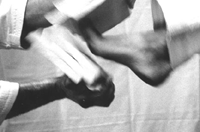 nd highly refined animal strike may be your only saving grace when you face a deadly opponent of greater strength or determination.
nd highly refined animal strike may be your only saving grace when you face a deadly opponent of greater strength or determination.
About the Author: Based on Secrets of Uechi Ryu Karate and the Mysteries of Okinawa (1996) by Alan Dollar
and published by Cherokee Publishing. Information:
Alan Dollar, Cherokee Publishing, 1001 Fitzuren Rd., Antioch,
CA 94509 510-778-4400, fx 510-778-4468 email: Cherokee@aol.com

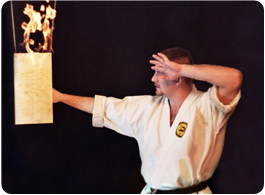

“Kanshiwa kata, created by Uechi Kanei, is the only Uechi-ryu kata that contains seiken punches.”
Is this from Dollar Sensei’s book? I’m sure there must be a confusion somewhere; all kata from Kanshiwa onward have shoken. Kanshiwa, Kanshuu, Seichin and Seisan most definitely finish with shoken.